 I feel like I have to start off with a huge apology for being so much of a novice at photography…and for being a it slow to figure it out.
I feel like I have to start off with a huge apology for being so much of a novice at photography…and for being a it slow to figure it out.
One of the main reasons for at lest a couple of us to visit the aquarium was to see the sea horses and sea dragons. And the jellies. Jellies are always cool. (You did know that medusa is synonym for jellyfish, right?)
But most of any aquarium visit is inside poorly lit rooms built to allow people to view the contents of variously sized glass boxes. That’s a real challenge for a mediocre photographer with a flash camera. Every photo has to be at an angle, which reduces the clarity (q.v. your physics classes on refraction and reflection), and some of them are bound to be just too damn dark.
Thus many of my photos of the creatures we really wanted to remember are substandard. Fortunately I figured out that I should switch to my iPhone instead while we still had some time remaining, so if you will bear with me through the trash, I hope that you’ll find some nuggets by the end. I’ve tried not to include anything that ended up being totally worthless.
But even if you don’t come in, have a pony on the house.
Most of the photos of jellies, taken with the flash camers, turned out dark, like the one below on the upper right. The tanks are dark so patrons might be able to see the jellies fluoresce, of course. The only one that came out half-way decent is on the upper left. I did try to play with some false-color versions. They are on the second row.
 |
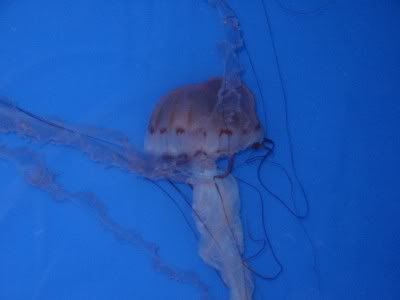 |
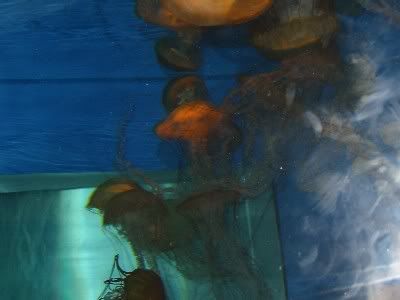 |
 |
 The best of the false color versions, in my opinion, appears to the left. I just wish something approximating the very subtle coloration of the jelly which one could see with the naked eye was visible. This jelly was gorgeous. I’m not an expert at identification, but it is quite possibly a sea nettle.
The best of the false color versions, in my opinion, appears to the left. I just wish something approximating the very subtle coloration of the jelly which one could see with the naked eye was visible. This jelly was gorgeous. I’m not an expert at identification, but it is quite possibly a sea nettle.
Not being a total idiot, I did run back to grab one photo of some jellies using my iPhone camera. That’s the shot below of the moon jellies. Sea nettles and moon jellies are both scyphomedusae. Jellyfish constitute an entire phylum; the jellies I have shots of are from the most common of the four classes, except for the very small and short-lived hydromedusae. Scyphomedusae are the large jellies most people think of when they think jellyfish.
So maybe you, kind reader, might be able to imagine the beauty that I was trying to catch when I took the others. And if that imaginative leap can be made, maybe displaying the images above wasn’t a total waste.
And now on to the family Syngnathidae, which includes the pipefishes, sea horses and sea dragons. This was our Holy Grail. So cool.
I have to admit that I didn’t know that pipefishes fit with the others at the time of our visit to the aquarium, but rather learned that during the development of this essay. It is therefore just a wonderful serendipity that I have a photo of some pipefish, below on the left side of the photo.
Pipefish have an extremely interesting swimming orientation. But I have to admit I felt a kinship. I often feel like I am living in a world perpendicular to the general drift.
I was actually trying to catch a shot of the sea horses hidden in the vegetation on the right. Can you see them? They are just below the reddish vegetation on the right.
The capability sea horses have at camouflaging is awesome. They have the ability to change colors and do so for social purposes, such as blushing yellow in the morning as a greeting.
But one might suppose that what interests me most about sea horses is their courtship ritual. I suppose one would be right.
When two parties discover a mutual interest at the beginning of breeding season, they court for several days, even while others try to interfere. During this time they have been known to change color, swim side by side holding tails or grip the same strand of sea grass with their tails and wheel around in unison in what is known as their “pre-dawn dance”. They eventually engage in their “true courtship dance” lasting about 8 hours, during which the male pumps water through the egg pouch on his trunk which expands and cleaves open to display an appealing emptiness. When the female’s eggs reach maturity, she and her mate let go of any anchors and snout-to-snout, drift upward out of the seagrass, often spiraling as they rise. “The female inserts her ovipositor into the male’s brood pouch, where she deposits her eggs, which the male fertilizes. The fertilized eggs then embed in the pouch wall and become enveloped with tissues.”[4] New research indicates the male releases sperm into the surrounding sea water during fertilization, and not directly into the pouch as was previously thought.[5] Most seahorse species’ pregnancies last approximately two to three weeks.
As the female squirts anywhere from dozens to thousands of eggs from a chamber in her trunk into his pouch, her body slims while his swells. Both seahorses then sink back to the bottom and she swims off. Scientists believe the courtship behavior serves to synchronize the movements of the two animals so that the male can receive the eggs when the female is ready to deposit them. The eggs are then fertilized in the father’s pouch which is coursed with prolactin, the same hormone responsible for milk production in pregnant women. He doesn’t supply milk, but his pouch provides oxygen as well as a controlled environment incubator. The eggs then hatch in the pouch where the salinity of the water is regulated. This prepares the newborns for life in the sea.[3] [6] Throughout the male’s pregnancy, his mate visits him daily for “morning greetings”. The female seahorse swims over for about 6 minutes of interaction reminiscent of courtship. “They change color, wheel around sea grass fronds, and finally promenade, holding each other’s tails. Then, the female swims away until the next morning, and the male goes back to vacuuming up food through his snout.” [3]
From one pregnancy, a male sea horse can give live birth to between 1 and 2000 fry. But the fry are small. Get it? Nyuk, nyuk, nyuk.
So I’ve got six photos below of sea horses, in various degrees of quality and yukitude. And varying stages of the dance.
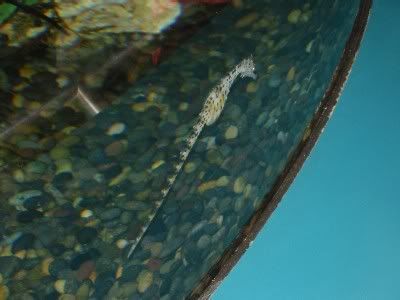 |
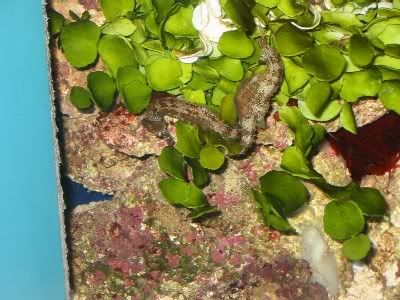 |
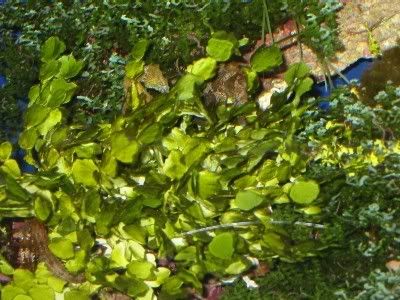 |
 |
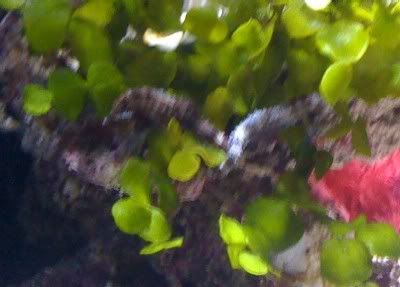 |
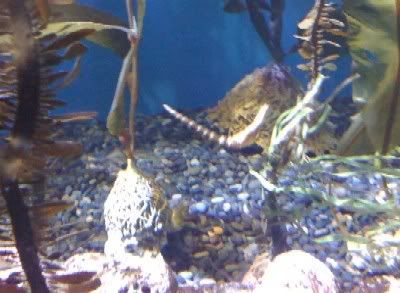 |
So there you have a sea horse swimming horizontally, some pre-dawn dancers and true courtship, as well as some pregnancy, which is sort of slimy-looking through the flash camera. The ballet of the sea horse on the lower right is included for its sheer beauty.
I did run back and take a couple of photos of the sea horse pregnancy with the iPhone. They look much better, I think,
I just wish the iPhone camera had a zoom feature.
 |
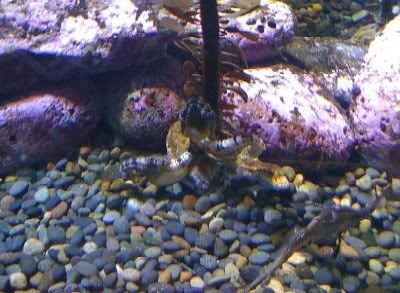 |
Did you know that each sea horse has a distinctive coronet on top of its head and that they are distinctive as fingerprints?
And finally there’s this:
The question of why it is the males who undergo pregnancy rather than the females is actually not entirely known, though some researchers believe male pregnancy allows for shorter birthing intervals, hence more offspring.
 As transfixing as sea horses can be, sea dragons can be mesmerizing. I didn’t see any weedy sea dragons, though that doesn’t mean they weren’t there. But leafy sea dragons R Us.
As transfixing as sea horses can be, sea dragons can be mesmerizing. I didn’t see any weedy sea dragons, though that doesn’t mean they weren’t there. But leafy sea dragons R Us.
And camouflage are them. The leafy parts have no other known purpose than camouflage, to make them appear to be just so much floating seaweed, often more than 18 inches long. They have pectoral and dorsal fins for propulsion.
There is a similarity with sea horses when it comes to mating behavior, in that the female lays her eggs on the tail of the male. However the eggs are not laid inside the male, but rather attach themselves to a brood patch. The eggs change color from bright pink to purple to orange as they mature, which takes about 9 weeks.
These first three photos were taken with the flash camera.
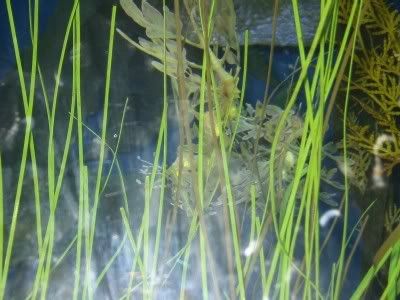 |
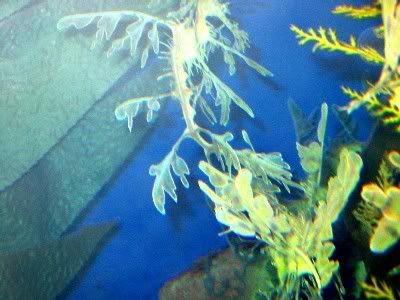 |
It was at that moment that it occurred to me to use the iPhone’s camera. And so I have the following dance of the sea dragons. I can’t really think of any words to add to these photos.

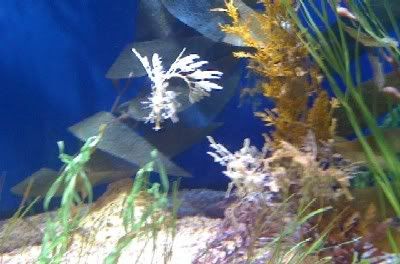 |
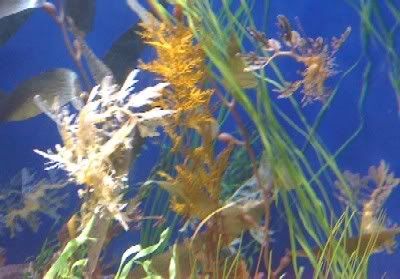 |
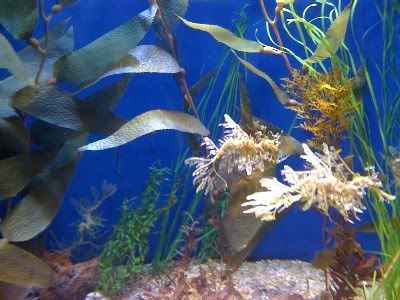 |
 |


8 comments
Skip to comment form
Author
…so I went searching and found this:
The music is a song called Chasing Cars by a band apparently named Snow Patrol.
Robyn
A moment of beauty in a time of much ugliness
I knew the male sea horses incubated the eggs, but I didn’t know about the courtship rituals, and morning greetings. Cool!
I learned lots of other tidbits too. Now if I can just remember them.
If not, imagine what you could have done with a real camera.
it’s so good to just see nature “a la naturel” sometimes to remind us of our “fortune” before we find a way to destroy it.
Wonderful pictures!